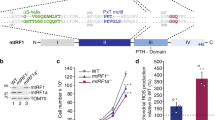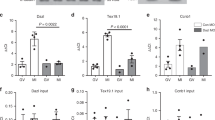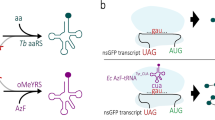Abstract
It is now clear that the genetic code used in mitochondria differs in a number of ways from the standard code1–3, the most prominent being the use of the opal codon UGA to specify tryptophan4–7. This change in the mitochondrial genetic code is accommodated by the presence of an anticodon U*CA in mitochondrial (mt) tRNATrp from yeast8 and Neurospora crassa1. Furthermore, the translation of a mtDNA-encoded mRNA has been achieved in a eukaryotic cell-free system9: the mRNA of subunit II of yeast cytochrome c oxidase, which contains UGA codons in its reading frame, can be translated into a full-length protein if the system is supplemented with the Schizosaccharomyces pombe10 cytoplasmic UGA suppressor tRNASer. It remains to be demonstrated whether a mitochondrial tRNA would be able to function in cytoplasmic protein synthesis. In the case of mt tRNATrp, this would cause the production of readthrough proteins due to the suppression of the UGA termination codon present in certain cytoplasmic mRNAs. Using the Xenopus oocyte microinjection system11–12, we show here that the mt tRNATrp from Saccharomyces cerevisiae, when injected together with rabbit globin mRNA, suppresses UGA termination with high efficiency, thus leading to the production of a β-globin-related readthrough protein of molecular weight (Mr) 18,500. However, the suppressor activity of this tRNA within the oocyte cytoplasm is strictly dependent on the co-injection of an exogenous (Escherichia coli) acylating enzyme which is needed to charge the mt tRNATrp in vivo. The absence of an endogenous enzyme capable of acylating the yeast mt tRNATrp suggests that there is a biological barrier for the activity of a mt tRNA in the cytoplasm if a tRNA exchange between the two cellular compartments occurred.
This is a preview of subscription content, access via your institution
Access options
Subscribe to this journal
Receive 51 print issues and online access
$199.00 per year
only $3.90 per issue
Buy this article
- Purchase on Springer Link
- Instant access to full article PDF
Prices may be subject to local taxes which are calculated during checkout
Similar content being viewed by others
References
Heckman, J. E., Sarnoff, J., Alzner-Deweerd, B., Yin, S. & RajBhandary, U. L. Proc. natn. Acad. Sci. U.S.A. 77, 3159–3163 (1980).
Barrell, B. G. et al. Proc. natn. Acad. Sci. U.S.A. 77, 3164–3166 (1980).
Bonitz, S. G. et al. Proc. natn. Acad. Sci. U.S.A. 77, 3167–3170 (1980).
Barrell, B. G., Bankier, A. T. & Drouin, J. Nature 282, 189–194 (1979).
Macino, G., Coruzzi, G., Nobrega, F. G., Li, M. & Tzagoloff, A. Proc. natn Acad. Sci. U.S.A. 76, 3784–3785 (1979).
Fox, T. D. Proc. natn. Acad. Sci. U.S.A. 76, 6534–6538 (1979).
Young, I. G. & Anderson, S. Gene 12, 257–265 (1980).
Sibler, A. P., Bordonné, R., Dirheimer, G. & Martin, R. P. C.r. hebd. Séanc. Acad. Sci., Paris 290, 695–698 (1980).
De Ronde, A., Van Loon, A. P. G. M. Grivell, L. A. & Kohli, J. Nature 287, 361–363 (1980).
Rafalski, A., Kohli, J., Agris, D. & Söll, D. Nucleic Acids Res. 6, 2683–2695 (1979).
Gurdon, J. B. Nature 248, 772–776 (1974).
Bienz, M., Kubli, E., Kohli, J., De Henau, S. & Grosjean, H. Nucleic Acids Res. 8, 5169–5178(1980).
Keith, G., Roy, A., Ebel, J. P. & Dirheimer, G. Biochimie 54, 1405–1426 (1972).
Brown, D. D. & Littna, E. J. molec. Biol. 20, 95–112 (1966).
Gatica, M., Tarrago, A., Allende, C. C. & Allende, J. E. Nature 256, 675–678 (1975).
Gatica, M. & Allende, J. E. Biochem. biophys. Res. Commun. 79, 352–356 (1977).
Giglioni, B., Gianni, A. M., Comi, P., Ottolenghi, S. & Rungger, D. Nature new Biol. 246, 99–102 (1973).
O'Farrell, P. H. J. biol. Chem. 250, 4007–4021 (1975).
Bienz, M. et al. Nucleic Acids Res. 9, 3835–3850 (1981).
Hirsh, D. & Gold, L. J. molec. Biol. 58, 459–468 (1971).
Marbaix, G., Huez, G., Nokin, P. & Cleuter, Y. FEBS Lett. 66, 269–273 (1976).
De Robertis, E. M., Partington, G., Longthorne, R. F. & Gurdon, J. B. J. Embryol. exp. Morph. 40, 199–214 (1977).
Laemmli, U. K. Nature 227, 681–685 (1970).
Author information
Authors and Affiliations
Rights and permissions
About this article
Cite this article
Martin, R., Sibler, AP., Dirheimer, G. et al. Yeast mitochondrial tRNATrp injected with E. coli activating enzyme into Xenopus oocytes suppresses UGA termination. Nature 293, 235–237 (1981). https://doi.org/10.1038/293235a0
Received:
Accepted:
Issue Date:
DOI: https://doi.org/10.1038/293235a0
This article is cited by
-
Orthogonality of Pyrrolysine tRNA in the Xenopus oocyte
Scientific Reports (2018)
Comments
By submitting a comment you agree to abide by our Terms and Community Guidelines. If you find something abusive or that does not comply with our terms or guidelines please flag it as inappropriate.



